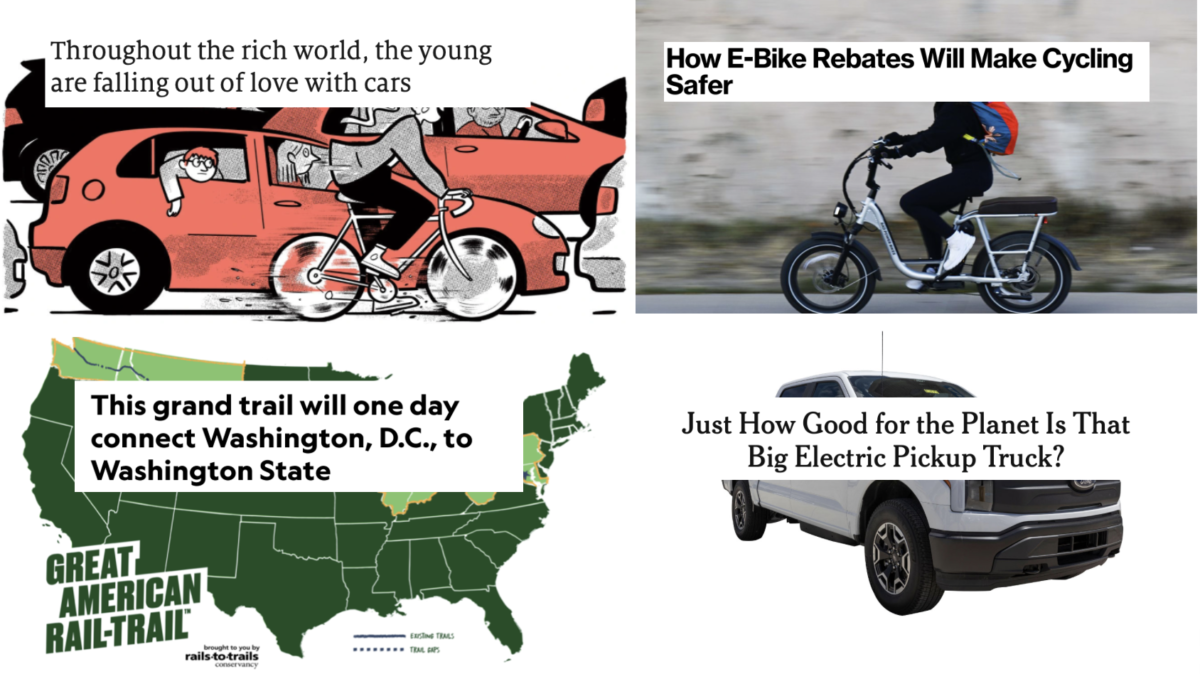
Welcome to the week.
Here are the most notable stories our writers and readers have come across in the past seven days…
The future is carfree: Young people (including Portland youth climate activist Adah Crandall, who was featured in this article!) are envisioning a world beyond cars. (The Economist)
Bike across America: Learn about the 3,700-mile Great American Rail-Trail, which would make bike trips from Portland, Oregon to Portland, Maine more feasible. (National Geographic)
The need for freight regulation: The Norfolk Southern catastrophe in Ohio is the latest display of the dangers of the all-powerful freight industry in the United States. (The Guardian)
The electric pickup truck test: Not all electric vehicles are created equal when it comes to emissions reductions (or safety for vulnerable road users). (The New York Times)
E-bike incentives lead to safe streets advocates: A “hidden power of e-bike incentives”? More people are realizing how important safe bike infrastructure is, and asking their leaders to listen. (Bloomberg CityLab)
Why teenagers in New York aren’t riding the subway: Some Manhattan parents are anxious about letting their older kids get around by themselves, and they’re missing out on a rite of passage for New Yorkers (and city kids everywhere). (Curbed)
Thanks to everyone who shared links this week.


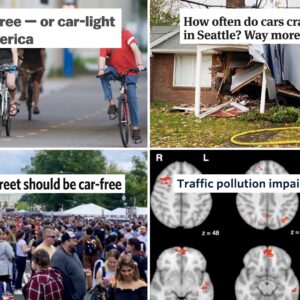
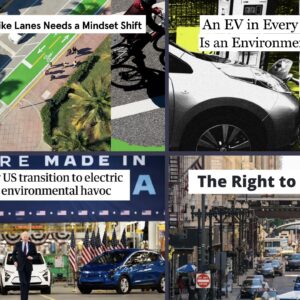
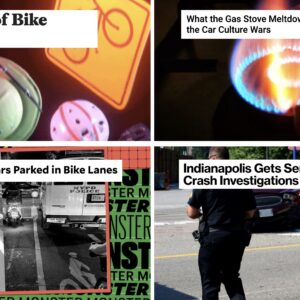
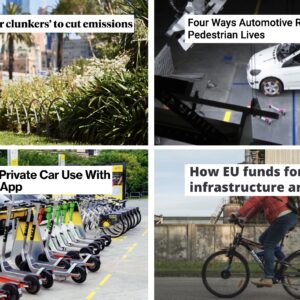
Thanks for reading.
BikePortland has served this community with independent community journalism since 2005. We rely on subscriptions from readers like you to survive. Your financial support is vital in keeping this valuable resource alive and well.
Please subscribe today to strengthen and expand our work.
The big railroad companies are a bunch of corporate looters. They are running our infrastructure into the ground, not repairing it, abandoning it, laying off their workforce, and then turning those profits into stock buybacks. Outside BNSF (which has tons of issues I won’t touch on), the major US railroaders all practice “Precision Scheduled Railroading” which is just a fancy way of saying “really long trains, fewer workers, and fewer safety inspections”. It’s been going on for a long time at this point, and the USDOT is uninterested in doing anything productive to stop it.
The East Palestine derailment was 100% preventable – it was caused by a “hotbox” on a worn out bearing. Since the advent of modern tapered roller bearings in the early 1900s, this has largely been a minor/nonexistent issue in railroading. Hotboxed bearings literally burn, and the only reason this kind of thing is missed is because Norfolk Southern would rather derail the train and take the losses than have proper safety protocols. When a train with hazmat chemicals is 1+ mile long, and the crew is two guys driving the locomotive in the front they probably can’t physically see the fire starting on the train, and they are forced by management to ignore safety/signaling warnings that would have told them about it.
In this context, Norfolk Southern management should be held criminally liable for the damage to both East Palestine and the countries physical infrastructure.
It’s ironic that an utterly ridiculous and dangerous vehicle like the Ford F150 lightning has lifetime emissions similar to the most fuel-efficient ICE cars but the OP chose to write a blurb that focuses on their emissions as the primary issue.
All personal SUVs and trucks should be phased out because they are antisocial vehicles that contribute to tens of thousands of deaths in the USA alone. This is true whether it’s the SUV you claim to need (because you have kids or dogs) or some tech-bro’s F150 lightning.
With ~3 million pickup trucks being sold every year (pre-COVID, don’t know about now) you’re going to have to come up with something better than “anti-social” to get people to not want to buy them.
Full disclosure: I own a 20 year old F150 and still use it for hauling lumber, furniture, and many other things our car could never.
We’re living in the future where I thought we’d all be zipping around in tiny, efficient little pod cars. Instead we’re using our latest tech to keep driving ever bigger vehicles with minimal gain. It is interesting that the e-F150 is better than an efficient ICE car, but what about the most efficient electric vehicles? That’s where we should be headed, and I wish the author touched on that more.
“The larger batteries in larger electric vehicles require more of these materials. The battery used to power General Motors’ Hummer E.V., for example, uses about the same amount of lithium per rider as three smaller car batteries or 240 electric bike batteries, according to a recent report. And it uses about half as much lithium as a battery that can power an entire electric bus.”
It’s always worth remembering that no matter the energy source, the more extra mass is piled on to transport the average 1.5 humans (or whatever that is these days), the less efficient that trip is. I think there’s some techno-utopian vision where we develop some energy source where the energy and the raw resources required to harness that energy is so cheap and plentiful that that efficiency pragmatically doesn’t matter – and I think that’s a pipe dream.
And that’s setting aside that these climate-controlled, sealed off boxes are, as narm puts it, inherently antisocial (which is me going further than just SUVs and trucks), and I suspect that’s actually doing more damage to the fabric of society than anyone realizes. I’ve claimed in the past that automobiles encourage sociopathy, and now there’s supporting evidence for that: https://psyarxiv.com/egnmj (“Motornomativity: How Social Norms Hide a Major Public Health Hazard” – covered on the War on Cars/etc lately).
jevons paradox is an intrinsic part of what makes north american extractive capitalism so bloody successful.
now let’s see the footprint of an ebike vs. a human powered one.
Propel put a video out on their YouTube a couple months ago that put forward the claim that an ebike is more efficient that both walking and analog biking.
Boy, do I miss the good old days of the internet when news stories were free, really free, of paywalls, asking for my email so they can spam me, and so on.
https://gitlab.com/magnolia1234/bypass-paywalls-chrome-clean
https://gitlab.com/magnolia1234/bypass-paywalls-firefox-clean
Maybe we should regard the democratization of information and free internet news as a temporary thing, of the 90s and aughts, that now prices are being imposed, doubled, and tripled even when inflation is only 6.4%, because providers can raise their rates. My newspaper subscription cost has tripled while my comics page has gone from 2 pages to just a quarter page; my Economist subscription rate more than doubled without any improvement in content – I’ve had to cancel it for the first time in 30 years; and now Biketown rates are rising by 50%.
I get it, that folks in the media have to eat too, that their Ford F-150 isn’t going to pay for itself, but for those of us who are poor, receiving good solid relatively unbiased news and information is becoming an increasingly unaffordable option – is it any wonder poorer people “buy” into conspiracy theories, particularly when they are free?
And so PB is increasingly reflecting a new Portland culture – that the new Portland is for rich folks only, those who can afford the online subscriptions and Biketown price increases – and the rest of us either need to turn pirate or else leave for other shores.
Bummer.
Exclusionary urbanism is definitely a bummer and, yes, this blog increasingly reflects this reality.
These are useful, but I have Bypass Paywalls Clean for Firefox and lately cannot read NYT articles. They’ve found a way to defaeat it. The articles don’t open either with the 12ft.io site.
Very interesting and thought provoking articles. I look forward to a carefree future.
Regarding the article “The Future is Car Free”…another interesting point often missedin this genre of news articles is that many job announcements for professional positions in the US often have a written requirement for a drivers license. In my national review of similar positions over the last 10 years, only some positions in WA state have added the flexible language similar to ‘or reliable mobility by other means’. It is going to be interesting for HR departments [and supervisors] to juggle this issue along with continued strong desired for majority remote work for the recent generation starting to replace the last of the boomers. Plus reinforce any adopted climate goals their agency, department, or firm may have.
More and more HR guidance judges the ‘only DL’ requirement as potentially discriminatory per ADA, see link.
https://hrdailyadvisor.blr.com/2020/09/15/can-employers-require-employees-to-have-drivers-licenses/
Additionally, many other job descriptions do not include a written requirement for a DL, but try to enforce it adminstratively. The U.S. Court of Appeals for the Fourth Circuit (Maryland, North Carolina, South Carolina, Virginia and West Virginia) recently ruled in [the case Stephenson v. Pfizer, Inc.] that driving is not necessarily an ‘essential function’ in jobs that require a lot of driving but primarily exist for other reasons.” – L. Pokrzywa
https://eastcoastriskmanagement.com/driving-listed-requirement-job-descriptions/
Stephenson v. Pfizer, Inc.
https://law.justia.com/cases/federal/appellate-courts/ca4/14-2079/14-2079-2016-03-02.html
Similarly, I’m an independent consultant and a standard contract requirement with many state and local governments is to carry $1 million in auto insurance coverage, regardless of whether travel is associated with the job. I was successful one time negotiating with Metro to promise that I would not drive in any way associated with the job and only bike/bus to their offices as needed (back when we had in-person meetings), but haven’t gotten any other agencies to agree since. I would love to see that requirement change!
The story of kids afraid to ride the subway in NYC is sad. Risk of death or injury is way less likely on the subway than in a car on the street or the awful freeways they have in NYC. My son, who grew up in PDX, moved to Brooklyn in 2019 and is happily car free. When I visit I walk way more than I do in Portland and I love the freedom of not having to worry about a car and parking. It’s harder to be car free in PDX because so many of the bus lines have 30 minute headways and the MAX doesn’t go enough places (we couldn’t even fund the SW corridor MAX!). Independence used to be a hallmark of people who grew up in NYC. They didn’t need their parents to drive them around like kids in most other cities do. It will be sad if we lose that. More cities should have the transportation options of NYC.
Come back to reality ROH. NYC has good transportation options because its population density is almost 30k per square mile. No other US metro area even comes close to that density. SF comes closest at about half of NYC’s density. Even along the busy NE corridor Boston, Philadelphia, Washington DC all have densities less than half of NYC. You’re not going to transform every US metro area into a NYC overnight.